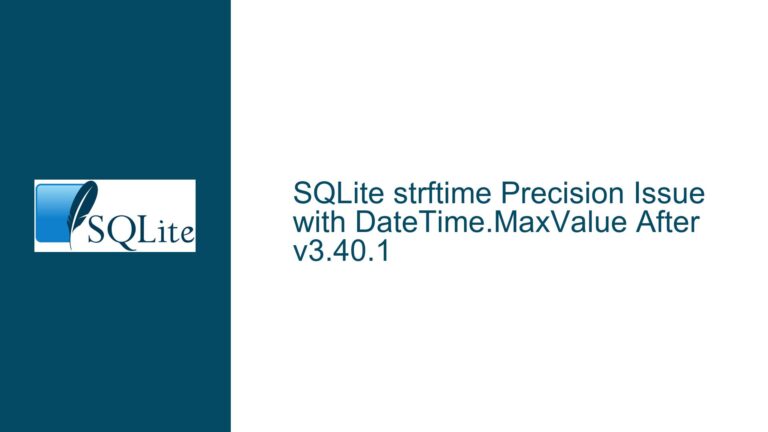Cross Join Order with pragma_table_info Causes Missing Results in SQLite
Understanding the Impact of JOIN Order on Table-Valued Functions
Issue Overview: Mismatched Results When Reversing CROSS JOIN with pragma_table_info
The core problem arises when using CROSS JOIN with SQLite’s pragma_table_info function in different positions within a query. The user observed that reversing the order of CROSS JOIN between a standard table and pragma_table_info leads to unexpected results:
- When
pragma_table_infois on the right side ofCROSS JOIN, the query returns the expected column names from dynamically referenced tables. - When
pragma_table_infois on the left side ofCROSS JOIN, the query returns no results.
Key Observations
Behavior with
CROSS JOINvs. PlainJOIN
UsingCROSS JOINenforces a specific loop order for query execution. In contrast, omittingCROSS(i.e., usingJOINwithout anONclause) allows the query planner to reorder tables for optimization.Dependence on Parameter Passing
pragma_table_infois a table-valued function requiring a table name as an input parameter. This parameter (tin the example) must come from a column in another table (tab.t). The parameter acts as a hidden filter, making the function’s output dependent on the outer loop’s data.Query Planner Constraints
TheCROSS JOINkeyword restricts the query planner’s ability to reorder tables. Whenpragma_table_infois placed in the outer loop (left side ofCROSS JOIN), SQLite cannot resolve the parametertbecause the inner loop (thetabtable) has not been processed yet. This creates a logical dependency cycle, resulting in no output.Error Handling for Invalid Parameters
Attempting to reference a non-existent column (e.g.,badcol) in thepragma_table_infofunction correctly triggers an error. This confirms that SQLite validates column names in the outer context but does not warn about logical dependency mismatches inCROSS JOINorder.
Underlying Mechanics
- Virtual Table Execution Flow:
pragma_table_infois implemented as a virtual table. Virtual tables with parameters require those parameters to be resolved before they are queried. This is analogous to a function call where arguments must be evaluated before the function runs. - Loop Nesting in Joins: SQLite processes joins by nesting loops. For
A CROSS JOIN B, SQLite iterates over all rows ofA, and for each row, iterates over all rows ofB. IfBdepends on values fromA, this works. Reversing the order (B CROSS JOIN A) breaks the dependency chain ifBrequires data fromA.
Root Causes: Why JOIN Order and CROSS JOIN Matter
1. Parameterized Virtual Tables Require Outer Loop Context
pragma_table_info is not a static table; it dynamically generates rows based on its input parameter (the table name). For the parameter to resolve correctly, the source of the parameter (the tab.t column) must be in an outer loop relative to the virtual table. This is enforced automatically when using JOIN but restricted by CROSS JOIN order.
Example:
-- Works: tab (outer loop) → pragma_table_info (inner loop)
SELECT name FROM tab CROSS JOIN pragma_table_info(t);
-- Fails: pragma_table_info (outer loop) ← tab (inner loop)
SELECT name FROM pragma_table_info(t) CROSS JOIN tab;
In the failing case, pragma_table_info is processed first and has no value for t because tab hasn’t been read yet.
2. CROSS JOIN Enforces Fixed Loop Ordering
The CROSS JOIN keyword explicitly tells SQLite to process the left table first (outer loop) and the right table second (inner loop). This overrides the query planner’s ability to reorder tables based on efficiency or dependencies.
Contrast with Implicit JOIN:
When CROSS is omitted, SQLite’s query planner analyzes the query and automatically places tab in the outer loop to satisfy the parameter dependency of pragma_table_info. This is why JOIN works while CROSS JOIN fails when the order is reversed.
3. Lack of Error Detection for Impossible Nesting
SQLite does not throw an error when a parameterized virtual table is placed in an outer loop without access to its required parameters. Instead, it silently returns no rows, which can be misleading. This is a known behavior in SQLite’s virtual table implementation, where missing parameters are treated as empty inputs rather than errors.
Resolving the Issue: Strategies for Reliable Parameter Passing
1. Use Implicit JOIN Instead of CROSS JOIN
Replace CROSS JOIN with JOIN to allow the query planner to reorder tables based on parameter dependencies:
-- Correct: Let the query planner choose the optimal loop order
SELECT name FROM pragma_table_info(t) JOIN tab;
This works because SQLite recognizes that tab must be in the outer loop to supply t to pragma_table_info.
2. Explicitly Enforce Correct Loop Order with Subqueries
If you must use CROSS JOIN, ensure the parameter source is in the outer loop. For complex queries, use subqueries to isolate the parameter resolution:
SELECT name FROM tab, (SELECT * FROM pragma_table_info(t));
Here, the comma join implicitly treats tab as the outer loop.
3. Avoid Parameterized Virtual Tables in Outer Loops
Design queries so that virtual tables with parameters are always in inner loops. This aligns with SQLite’s execution model and prevents unresolved dependencies.
4. Validate Parameters with COALESCE or Error Handling
Add checks to ensure parameters are not NULL or invalid:
SELECT name
FROM tab
JOIN pragma_table_info(COALESCE(t, 'fallback_table'))
WHERE t IS NOT NULL;
5. Use Schema-Qualified Table Names
Explicitly specify the schema (usually main) to avoid ambiguity:
SELECT name
FROM tab
JOIN pragma_table_info(t, 'main');
6. Monitor Query Plans with EXPLAIN
Use EXPLAIN to verify loop ordering. Look for OpenRead (table scans) and VFilter (virtual table processing) operations:
EXPLAIN SELECT name FROM pragma_table_info(t) JOIN tab;
Ensure OpenRead for tab occurs before VFilter for pragma_table_info.
7. Upgrade to SQLite 3.39.0 or Later
The user’s example uses SQLite 3.39.0, but older versions may have different behaviors. Newer versions include optimizations for virtual table parameter handling.
8. Consider Alternative Approaches for Dynamic Metadata
If pragma_table_info proves unreliable in joins, extract table names first and process metadata in separate steps:
-- Step 1: Get table names
CREATE TEMP TABLE temp_tables AS SELECT t FROM tab;
-- Step 2: Process metadata
SELECT name
FROM temp_tables
JOIN pragma_table_info(t);
Deep Dive: How SQLite Processes Joins with Virtual Tables
Virtual Table Internals
SQLite treats virtual tables like pragma_table_info as functions that return rows. The arg and schema parameters are implicitly passed based on the query context. When the virtual table is in an inner loop, SQLite can bind parameters from the outer loop.
CROSS JOIN as a Query Planner Directive
CROSS JOIN is not just a syntactic sugar for a Cartesian product—it directly influences the query planner’s loop ordering. This is critical for parameterized virtual tables, where loop order determines parameter availability.
Comparison with Other Databases
- PostgreSQL: Allows
LATERAL JOINto explicitly reference columns from preceding tables, similar to SQLite’s implicit parameter binding. - MySQL: Does not support parameterized virtual tables in the same way; metadata is accessed via
INFORMATION_SCHEMAstatic tables.
Best Practices for pragma_table_info
- Always place
pragma_table_infoin the inner loop. - Use
JOINwithoutCROSSunless loop ordering is explicitly required. - Test queries with
EXPLAINto confirm parameter binding.
By understanding these principles, developers can avoid subtle bugs in query design and leverage SQLite’s flexibility effectively.






